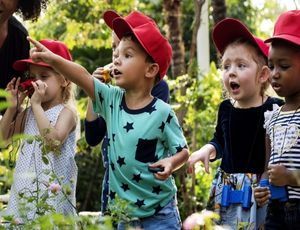Welcome to the Small Hands, Big Work newsletter. We will accompany you on your Montessori journey as your little one grows up. We know every parent wants the best for their child, and that is why we created this tool, where we will share month by month how to support your child´s development based on Montessori philosophy not only at school, but also at home. We have many suggestions for books, videos, podcasts, and other tools to enrich your journey included in each newsletter you will receive. So, let´s get started! This month we will look into what Montessori is and what does it mean to live this philosophy daily with your child.
What is Montessori?
Dr. Maria Montessori founded the Montessori philosophy 113 years ago in Rome, Italy. She was one of the first Italian female doctors in the late 1800’s. She started working in an asylum where she observed children with emotional and mental disabilities who were sensorially deprived in their environment. She applied the same scientific observation from her medical training to identify what engaged children and how she could facilitate learning experiences for them. She noticed all children had natural tendencies and characteristics that allowed them to learn naturally if exposed consistently to a prepared environment that specifically met their needs. She built her ideas around only those commonalities that are present in all human beings.
The first “Casa dei Bambini” opened in San Lorenzo, Rome, in January 1907. This educational system she created is based on the dynamic relationship between three main elements: the child, the adult, and the learning environment. The interaction between the three of them should be based on mutual respect. Each child follows their interest and own pace through the materials in the environment, and the teachers, who were called guides or directresses practice scientific observations daily for the entire group of children.
Rapidly, her students started learning effortlessly and joyfully without the need for extrinsic motivations or the use of grades. Her success gave her international fame, and she started traveling around the world, sharing her philosophy. To this day, the North American Montessori Teacher Association estimates there are about 20,000 Montessori schools worldwide.
So now that you are reading this, you might be curious to know the principles of the Montessori philosophy:
1. The environment needs to be prepared.
It can be any space we carefully prepare for a child: at home, at school, outdoor space, or even a holiday rental. In this space, all the items the child will use should be at his reach. The adult carefully places them in sequence and orderly, making sure they are clean and in good shape and removing any clutter from the space. This will allow the child the freedom to explore and learn naturally.
2. All children have a natural desire to learn.
Dr. Montessori recognized that all children have an innate desire to learn. There is no need to bribe them or force them to learn. They are driven to explore and make discoveries for themselves. They are intrinsically curious learners if we allow them to be.
3. Hands-on experiences should be offered to provide concrete learning.
In her book, “The Absorbent Mind,” Dr. Montessori says, “The hands are the instrument of man’s intelligence.” When we use our hands to experience something, we are moving from passive learning to active learning; the hand takes in information in a concrete way to pass on to the brain. It is not enough to listen and watch something; learning will be more profound if we integrate our hands also.
4. All children have sensitive periods.
Dr. Montessori observed that all children have sensitive periods when they show particular interest in one area- for example, movement, language, order, math, reading, or sensorial exploration. During this period, the child absorbs and learns a specific skill effortlessly and with ease. Understanding this will help us prepare the environment appropriately to satisfy the needs of the child and to understand better why they do what they do. If the sensitive period is gone, the child will still learn the skill, but it will require more conscious effort.
5. All children have an unconscious-absorbent mind.
Children are born with an absorbent mind; they can take in any information in the environment without effort. Until they are three years old, this is unconscious; the child will absorb every stimulus found in the environment. From three years to six years, this absorbent mind is conscious, and the child will be able to choose what to absorb from the environment.
6. All children should experience freedom and limits.
Children in a Montessori environment have freedom within limits. When children have the opportunity and freedom to decide which material they want to use at school or what to wear at home, they start developing will. Freedom of movement, expression, and observation are always available to the child; the adult marks the limit. For instance, there is the freedom to move around the room with the limit of not stepping on the material of a peer or climbing the chairs and tables.
7. All children want independence and responsibilities.
One of the main goals of Montessori education is for the child to be independent. Every decision we make as adults impacts the way a child depends on the adult or the way the child becomes independent. Children love to do things by themselves. They want to contribute and be part of society. There is satisfaction on their face when they achieve something by themselves. Independence is how children become responsible for themselves, the environment, and others.
8. The developmental pace of each child is individual and unique.
Montessori respects how each child learns since they have different energy levels, interests, attention spans, and pace. We aim to respect and nourish each unique developmental timeline.
9. All children deserve respect.
Children should be treated the same way we want to be treated. The way the adult speaks and moves in the environment is purposeful. We aim to respect their concentration, work, and effort. This includes recognizing when we are an obstacle for their development, and we consciously remove ourselves from the picture to respect what the child is doing independently. There is a two-way communication with the child instead of a one-way directive dialogue from the adult. We understand every child has a voice, and we aim to understand it, even in very young infants that are non-verbal.
10. Observation is the primary tool to support the development of each child.
There is no Montessori without observation from the adult. Observation shows us exactly where the child is right now. We identify what they are interested in, what they are working on, and what they have mastered. When we observe, we understand what we need to offer or remove for the child to be successful in any learning experience.
These principles can be present not only at school, but also at home; it takes preparation and understanding of the adult to provide a nourishing environment for the child.
Book of the Month
Montessori from the Start: The Child at Home from Birth to Age Three by Paula Polk Lillard and Lynn Lillard Jessen.
This is a great book that focuses on the first three years of life with very practical tips and a solid mind frame on how to introduce Montessori principles into your baby or young child's life. Concepts like independence, concentration and freedom of movement are widely explained and you will read examples of how to foster them at home along with the positive impact they have one your child's early development.
Link to buy it: https://www.amazon.com/Montessori-Start-Child-Birth-Three/dp/0805211128
Have a little extra time?
Dr. Montessori outlined ten rules for adults who work with children. These can usually be found on display at schools that use this philosophy as their basis, reminding parents and staff members how Maria Montessori saw the role of the adult in education.
- Never touch the child unless invited by him (in some form or the other).
- Never speak ill of the child in his presence or absence.
- Concentrate on strengthening and helping the development of what is good in the child.
- Be active in preparing the environment. Take meticulous and constant care of it. Help the child establish constructive relations with it. Show the proper place where the means of development are kept and demonstrate their proper use.
- Be ever ready to answer the call of the child who stands in need of you, and always listen and respond to the child who appeals to you.
- Respect the child who makes a mistake and can then or later correct himself but stop firmly and immediately any misuse of the environment and any action which endangers the child, his development or others.
- Respect the child who takes rest or watches others working or ponders over what he himself has done or will do. Neither call him nor force him to other forms of activity.
- Help those who are in search of activity and cannot find it.
- Be untiring in repeating presentations to the child who refused them earlier, in helping the child acquire what is not yet his own and overcome imperfections. Do this by animating the environment with care, with restraint and silence, with mild words and loving presence. Make your ready presence felt to the child who searches, and hide from the child who has found.
- Always treat the child with good manners and offer him the best you have in yourself and at your disposal.



